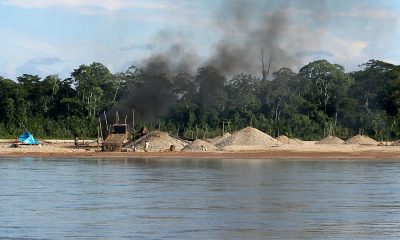Life exists 1,200 meters under the seafloor at 248 degrees Fahrenheit
They discovered a very small, but very active microbial community "thriving" in the seemingly uninhabitable conditions
Published
2 years ago onBy
Talker NewsBy Georgia Lambert via SWNS
Life exists at 248 degrees Fahrenheit 1,200 meters under the seafloor, scientists have discovered.
The tiny but "thriving" community of microorganisms was unearthed during a Japanese drilling expedition, new research reveals.
Since the discovery of the deep subseafloor biosphere within rock and sediment during the mid-1990s, scientists have been studying how organisms thrive in what is an isolated and generally food-deprived environment.
This has led them to wonder what conditions set the limit to the existence of life.
In 2016, a group of international scientists set out to sea onboard the Japanese scientific drillship named 'Chikyu', to find out what the temperature limit of the deep subseafloor biosphere was.
Sediment samples were then collected from a drill hole that cut through the boundaries of the geological subduction zone - where two of the planet's tectonic plates collided causing one to sink into the hot mantle underneath the other - off the Nankai Trough of Japan.
It was at this site that the scientists made a surprising discovery.
As they drilled deeper towards the Earth's crust, they observed the sediment getting hotter and hotter, until they were 1200 metres below sea level, when they recorded temperatures of 120 degrees Celsius (248 degrees Fahrenheit).
The scientists were confident that they were getting closer to reaching the "limit for life", but to their surprise, they discovered a very small, but very active microbial community "thriving" in the seemingly uninhabitable conditions.
The researchers then got to work counting the number of cells in the sediment before measuring their metabolic rates using highly sensitive radiotracer measurements of both methane production and sulphate reduction.
They discovered that the metabolic rates per cell were "extraordinarily high" for the deep biosphere and the samples collected in 2016 are still shedding light on the survival strategies executed by organisms living in this harsh environment.
As lead author Felix Beulig, a research scientist from the University of Bayreuth, explained: "We propose that the organisms are forced to maintain a high metabolic turnover, which approaches the activity of microbes living in surface sediments and in laboratory cultures, to provide the energy required to repair thermal cell damage."
Dr Beulig's colleague and the study's leader, Tina Treude, said: "The energy required to repair thermal damage to cellular components increases steeply with temperature, and most of this energy is likely necessary to counteract the continuous alteration of amino acids and loss of protein function."
Prof Treude, who is also a UCLA professor of marine geomicrobiology, added: "It is far from trivial to detect microbial metabolic activity in sediments with less than 500 cells per cubic centimetre sediment, which is seven orders of magnitude lower than in the average surface sediment."
Since the 2016 expedition, the study's team has conducted a large number of controlled experiments and analyses on the cell and sediment samples.
Florian Schubert, a scientist from the German Research Centre for Geosciences, who conducted these analyses as part of his PhD studies said: "We worked under extremely controlled, sterile conditions and performed a large number of control experiments simultaneously with the sample incubations.
"We even incubated sediment sterilised with high gamma radiation, as well as drill fluid from the drill hole, to detect any potential non-biological reactions or contamination-induced microbial activity."
Because the metabolic rate determinations were conducted under lab conditions, some uncertainty remained as to whether the microbes would show the same activity in their natural environment.
Knowing that this comparison could make all the difference, the team compared the measured metabolic sulphate reduction rates to their calculated depletion time of the dissolved sulphate found in the deep sediment at the site.
Arthur 'Art' Spivack, a geochemist and professor from the University of Rhode Island explained their findings, saying: "Given that we are comparing two very different methodological approaches that act on time scales of days versus millions of years, the agreement between the experimental rate determination and the calculated depletion time is gratifyingly good."
According to the researchers, by producing lots of methane and reducing sulphates to use as their energy source, the cells found in the sediment used hydrogen and acetate from the water as part of these reactions.
Verena Heuer from the Center for Marine Environmental Sciences (MARUM) in Germany, explained, saying: "Acetate - which is a small organic molecule that is also present in vinegar - is of particular interest as a potential food source.
"Acetate reaches concentrations of more than ten millimole per litre in the sediment porewater, which is exceptionally high for marine sediments."
Bo Barker Jørgensen from Aarhus University, who is one of the pioneers of deep biosphere research, added: "To find life thriving with high metabolic rates at these high temperatures in the deep seabed nourishes our imagination of how life could evolve or survive in similar environments on planetary bodies beyond Earth.
"The ultimate limits of the biosphere inside the Earth remain unknown.
"As shown by this project, the boundary resides somewhere in the oceanic crust beneath the sediments. It will be explored in the future through scientific ocean drilling."
The study's findings were published in the journal Nature Communications.
Stories and infographics by ‘Talker Research’ are available to download & ready to use. Stories and videos by ‘Talker News’ are managed by SWNS. To license content for editorial or commercial use and to see the full scope of SWNS content, please email [email protected] or submit an inquiry via our contact form.
You may like


Losing weight reduces risk of developing cancerous growths, new study reveals


Women fake orgasms to make men feel more macho, new study suggests


Gold rush transformed ‘pristine’ Amazon rainforests into ‘toxic’ wastelands


People with long COVID may have lung damage that doesn’t show up in routine testing


Synthetic blood cells could help stop people from bleeding to death


Why coffee and avocado toast could quickly become a thing of the past
Other Stories


Blood test can detect signs of knee condition 8 years before X-rays
Early detection could lead to treatments that slow the progression of the most common form of arthritis.


Man captures ultra rare albino squirrel on camera
The white squirrel has red eyes so is thought to be an albino squirrel.


Adorable dog kicks his leg while he walks
A video captured the pup bouncing along the street of his native China.


Woman with rare ‘Sleeping Beauty’ condition sleeps every four hours
She was diagnosed at age 18 after years of struggling to stay awake in school and nodding off during class.


97-year-old veteran receives WWII service medal 80 years later
"We’re all so proud of Eve."
Top Talkers

 Parenting1 week ago
Parenting1 week agoSingle mom details struggles of feeding her 12 kids

 Lifestyle1 week ago
Lifestyle1 week agoWoman regrets her tattoo nightmare: ‘It’s horrendous’

 Wildlife4 days ago
Wildlife4 days agoClever elephant returns visitor’s shoe that fell into enclosure

 Good News4 days ago
Good News4 days agoDisabled student takes first steps in 10 years on graduation stage

 Health5 days ago
Health5 days agoNew study reveals ‘old age’ begins later than it used to

 Animals10 hours ago
Animals10 hours agoAdorable dog kicks his leg while he walks

 Entertainment1 day ago
Entertainment1 day agoWhat is the perfect movie length?

 Broadcast16 hours ago
Broadcast16 hours agoAre allergies interfering with your social life?

